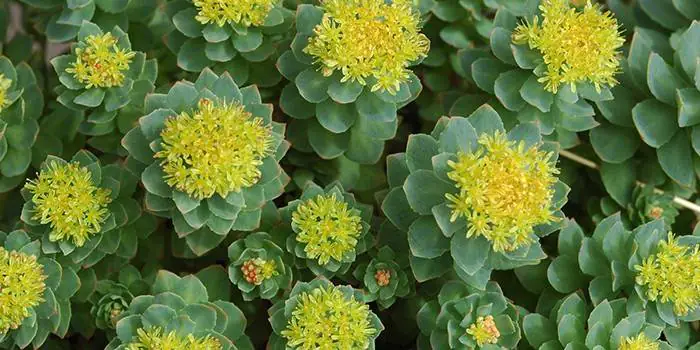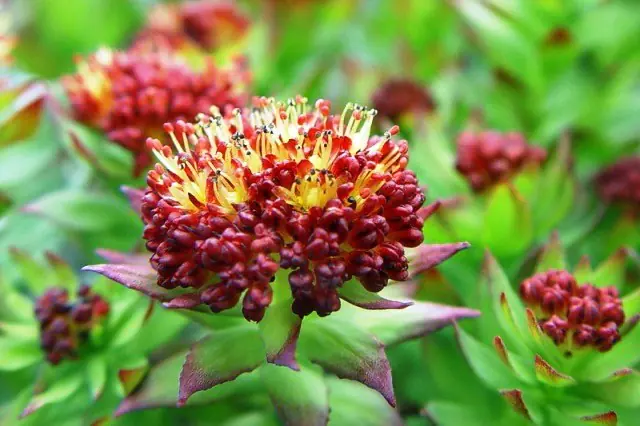Until recently, people knew very little about the benefits of golden root. Now this plant, also known as rhodiola rosea, is used almost everywhere: in medicine, cosmetology and even in sports. Read what the secret of this healing culture is, how and why it is used.
What is golden root
The homeland of Rhodiola rosea is Altai, but it is also grown in China, Bulgaria, and Mongolia. The herbaceous plant is considered a dioecious succulent from the Crassulaceae family. The root of Rhodiola rosea is very large, painted in a bronze, gilded tone. Many appendages should grow from it. On the surface there is a small herbaceous part, consisting of many stems of different heights with leaves, it looks like a flower. At a certain period, inflorescences are formed, on which the fruits subsequently ripen. Dig up the root twice a year.

Composition of Rhodiola rosea
The effectiveness of using a perennial plant is due to the rich list of substances and aromatic compounds contained therein and a short list of contraindications. The chemical composition of Rhodiola is presented:
- Glycosides. Substances that have a beneficial effect on the heart and blood vessels. They calm you down.
- Flavonoids. These substances increase the flexibility and elasticity of blood vessels, stabilize blood pressure and heart rate. They play an important role in the production of bile and urine, and make the adrenal cortex work more actively.
- Tannins. Change the structure of the protein.
- Anthraquinones. Substances that help strengthen the immune system. They have a laxative effect.
- Salidroside.
- Essential oils. They are excellent antiseptics, relieve inflammation, and heal wounds. They have a positive effect on the nervous system and have a neuroprotective effect.
- Coumarins. Substances that suppress tumor metastases, slow down the growth of tumors, and even help overcome the coxsackie B3 virus.
- Organic acids: oxalic, succinic, malic, citric. All of them have a beneficial effect on organs and systems.
- Phenols. Serve to strengthen and protect the circulatory system.
- Carbohydrates. Rose root contains glucose and fructose. The first carbohydrate provides energy for metabolism, and the second one normalizes blood sugar levels.
- Sterols. Lower cholesterol levels, strengthen the immune system and cardiovascular system.
- Gossypetin and rhodiol flavonoside. Kill Staphylococcus aureus.
- Alkaloids. Relieve pain and spasms, stop bleeding.
- Microelements. There is manganese, copper, zinc.
- Anthraglycosides. They have a laxative effect, enhancing colon peristalsis.
Properties
The scope of application of the plant is incredibly wide. It is difficult to list all the beneficial properties of Rhodiola rosea; there are practically no contraindications. It is used not only for treatment, but also for cosmetic procedures. Pink root is useful for:
- problems of the central nervous system;
- poor vision;
- hearing impairment;
- cardiovascular diseases;
- allergies;
- neurosis;
- with oxygen starvation;
- hypotension;
- pulmonary tuberculosis;
- VSD;
- decreased performance and chronic fatigue;
- impotence;
- smoking addiction;
- poor concentration, memory problems;
- colds;
- mountain sickness;
- scurvy;
- sleep disorders;
- acne and other skin problems;
- diseases of the stomach, intestines;
- uterine bleeding.
Rhodiola rosea is one of the most mysterious plants. It was considered a sacred herb by the Gauls, Persians, ancient Greeks and Romans. Ancient people sincerely believed that if you rub yourself with golden root, any wish will come true. It is also known as a plant against vampires and the evil eye. For the Druids, Rhodiola was a deity - according to their belief, a magical drink made from the herb cured all ailments.
What are the benefits of Rhodiola rosea for women?
Thanks to numerous studies, it is known why Rhodiola rhizome has been used in traditional medicine and the pharmaceutical industry. Contains vitamins A, B, C, E and P, chromium, phosphorus, selenium, anthocyanins and phenolic acids, glycosides, flavonoids, phytoestrogens.
For centuries, the plant has been used as a diuretic and expectorant (useful for dry coughs), to regulate the digestive system - improves appetite, prevents diarrhea and constipation.
For women during menopause, to maintain beautiful skin, healthy blood vessels and strong bones - Rhodiola rosea has a very wide use in natural medicine. Its properties have also been noticed by the pharmaceutical industry; in pharmacies you can find a very wide range of drugs based on this plant.
Rhodiola rosea has anti-inflammatory properties, so the prepared decoctions were used for gargling, in the form of compresses for wounds and burns. It was popular to use golden root to treat acne - when consumed in the form of tea, the severity of seborrhea and acne is reduced.
External use of radiola relieves swelling of insect bites, various types of eczema, psoriasis and brings relief during conjunctivitis.
In addition, a positive effect of Rhodiola rosea on hair was observed - it prevents baldness and reduces hair loss associated with hormonal disorders. It has a good effect on the circulatory system, strengthens blood vessels, reduces blood pressure and bad cholesterol levels.
Preparations with rhodiola extracts act on the nervous system and prevent osteoporosis. The leafy part has an antifungal effect, so it is used as decoctions in the treatment of colds and the respiratory system. There is evidence of the positive effect of Rhodiola as a prophylactic agent in the event of a threat of benign and malignant tumors.
Indications for use
Rhodiola rosea is one of the few plants that is taken for thyroid diseases. It also helps hypertensive patients, lowers cholesterol and blood sugar levels, and removes radioactive compounds from the body. By taking medicine from this plant, you can extend your life by 15-20 years.
- The plant, from roots to branches, contains a lot of healing substances. Golden root helps with bronchial asthma and rheumatism.
- Golden root tincture gives an excellent effect for cysts on the thyroid gland and seals.
- Biologically active substances that are formed in the leaves can improve blood circulation in the scalp and stimulate hair growth processes.
- This plant has a number of healing properties: firstly, it produces antibactericidal substances - phytoncides, which have a detrimental effect on most known microorganisms.
Rhodiola juice can heal wounds, frostbite, erosion, and also help with a runny nose, sinusitis, and sore throat. It helps with duodenal and stomach ulcers.
How to use Rhodiola rosea
For pharmacological purposes, the aerial part of the plant is completely used. Experienced folk healers advise drying flowers and leaves in pitch darkness. In their opinion, this unusual approach enhances the healing properties of the herb.
The chemical composition of Rhodiola rosea is a real treasure for people. The plant contains twenty microelements valuable for human life. Rhodiola rosea contains the phenolic compounds phenolic alcohols and their glycosides, flavonoids, salidrosia or rhodiolosides. Also in the composition of Rhodiola rosea you can observe various tannins, essential oils, organic acids, lipids and other components.
Experiments conducted by scientists have proven that salidroside has a protective effect on human red blood cells from oxidative stress and can be a good adaptogen for increasing the body's resistance to stress and fatigue. Salidroside suppresses tumor metastases of human lymphosarcoma cells and has an antiviral effect against coxsackievirus B3.
The substances contained in Rhodiola rosea have a stimulating effect on the human central nervous system. Some components of the plant (gossypetin and rhodiol flavonoside) have an antibacterial effect that prevents the development of Staphylococcus aureus and the activity of prostate cancer cells.
In the regions of Altai there is such a belief: whoever finds a golden root will be healthy and lucky for the rest of his life. Rhodiola rosea has long been used in folk medicine, as it has a lot of healing properties. It is actively used in the prevention of stress and the treatment of various diseases associated with the immune, nervous and endocrine systems of the human body. Doctors often recommend Rhodiola rosea as an additional nutritional supplement.
Rhodiola rosea plant extract is widely used in cosmetics. It is obtained as a result of vacuum extraction of golden root. This drug has such positive properties as stimulating, anti-stress, anti-inflammatory and adaptogenic effects. Most often, Rhodiola rosea extract is used in performance enhancing products, as an immunostimulating adaptogenic agent that increases the body's resistance to harmful factors. This substance cannot be included in one-component biologically active food additives.
Rhodiola rosea extract often becomes a component of anti-aging cosmetics. This substance has the ability to rejuvenate the skin and smooth out wrinkles. Golden root extract can also be found in anti-acne and dermatitis products. The main biological substances contained in the dry extract of Rhodiola rosea are salidroside and rhodioloside.
The content of the article

Medicinal properties of Rhodiola rosea tincture
Rhodiola rosea tincture is a wonderful remedy that has a tonic effect on the nervous system and improves performance. The product has an adaptogenic and stimulating effect, similar to the effect of ginseng and eleutherococcus preparations. Rhodiola rosea tincture contains a number of biologically active substances: beta-sitosterol, organic acids, tannins. The drug increases resistance to adverse factors (oxygen starvation, temperature changes and stress).
Rhodiola rosea tincture reduces mental stress, increases physical and mental performance by normalizing energy metabolism. The drug helps the body adapt to changes in climate and time zones, and has some antiarrhythmic effect. Rhodiola rosea tincture is prescribed for asthenic conditions, neurasthenia, increased fatigue, vegetative-vascular dystonia, as well as for akineto-hypotonic syndrome, sexual dysfunction (including erectile dysfunction). You can buy it at the pharmacy or prepare it yourself.
How to prepare and take Rhodiola rosea tincture
To prepare the tincture, grind 50 g of dried Rhodiola rosea roots, place the raw material in a glass container, pour in 500 ml of 40% alcohol (vodka). It is recommended to use a tinted glass bottle. It must be sealed and stored in a dark place for 20 days. Then strain the tincture. Store the finished medicine in a dark, cool place.
Take the drug 10-15 minutes before meals, preferably in the first half of the day. Adults and adolescents are prescribed 5-10 drops. 2-3 times a day. For asthenic or akineto-hypotonic syndrome, take 10 drops. products 2-3 times a day. If well tolerated, gradually increase the single dose of the drug to 30-40 drops. The course of treatment is 20 days.
Side effects, contraindications to the use of Rhodiola rosea
Side effects of the investigation include: insomnia, increased nervous excitability, instability of blood pressure, headache. Allergic reactions may develop. Rhodiola rosea tincture is not prescribed for hypersensitivity to the components, severe arterial hypertension, or fever.
The drug is contraindicated during pregnancy and lactation, and for children under 12 years of age. Rhodiola rosea is used with caution in patients with diabetes mellitus and diseases of the cardiovascular system. With the simultaneous use of Rhodiola tincture and psychostimulants, a mutual enhancement of the therapeutic effect is observed.
">



